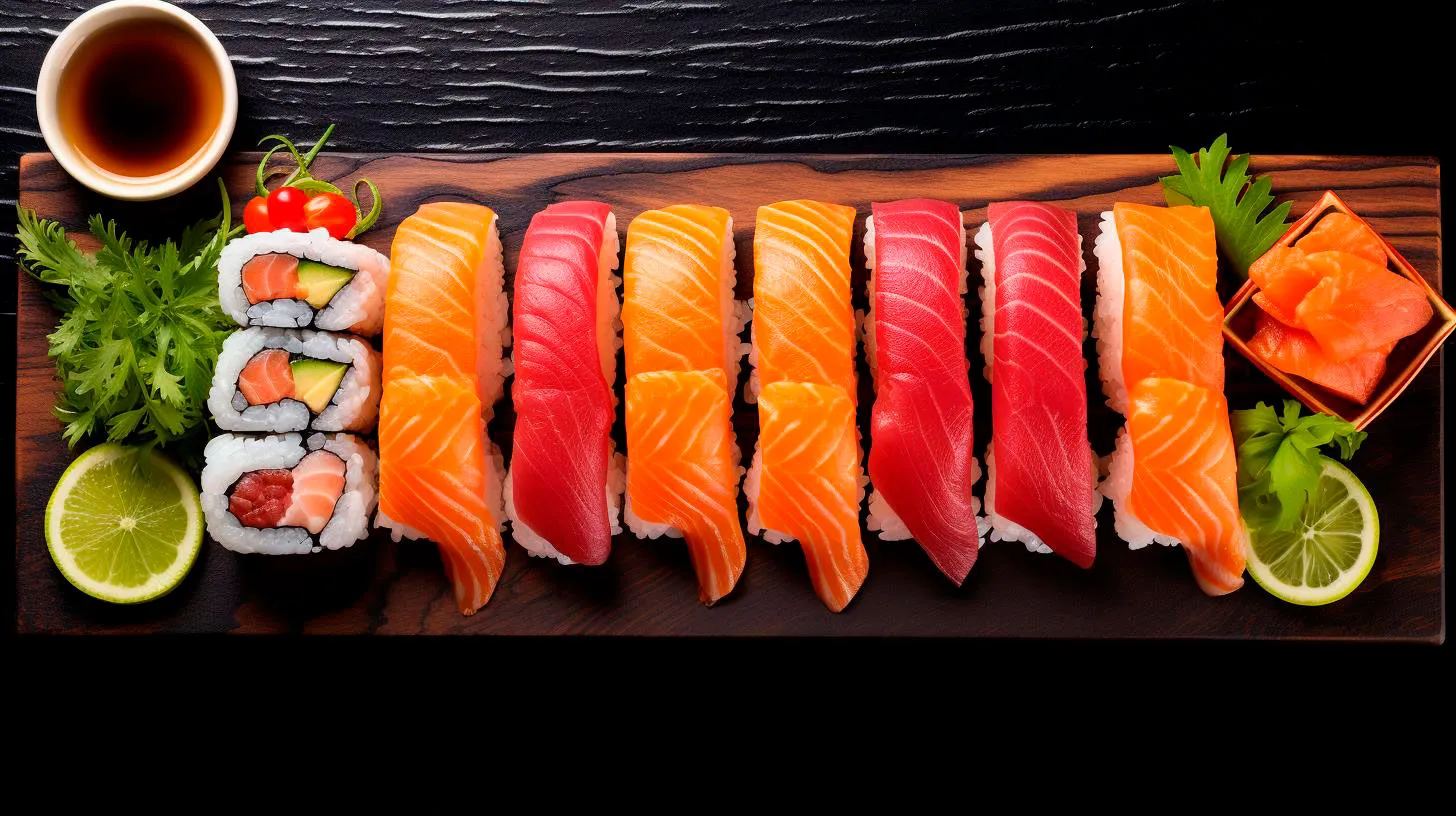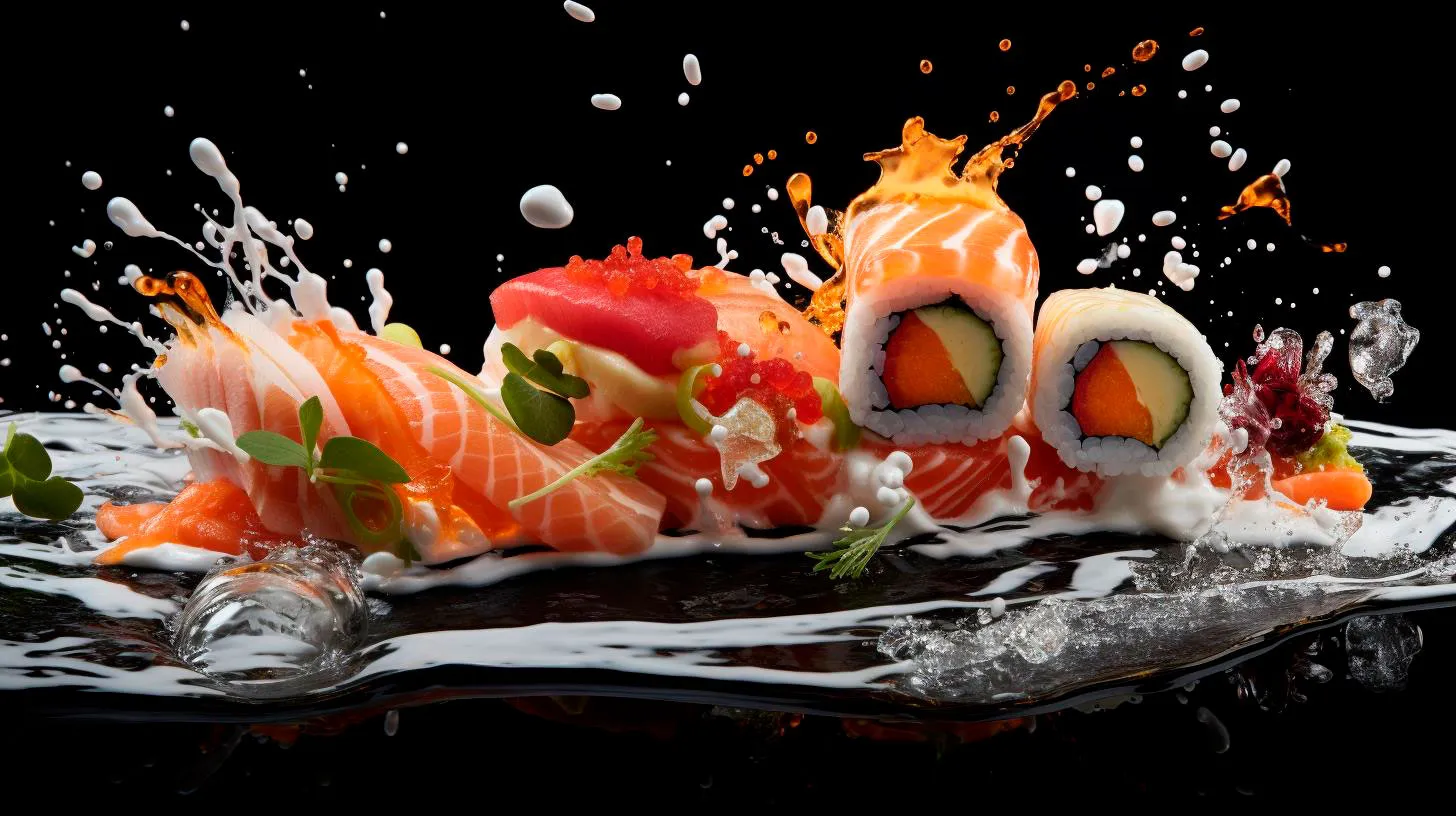Allergic Risks at the Sushi Bar: Knowing the Distinctions between Sushi and Sashimi
In this article, we will explore the differences between these two dishes, discuss the allergic risks associated with them, and provide some key takeaways to ensure a safe and enjoyable dining experience.
Understanding Sushi
Sushi is a Japanese dish that is made by combining vinegared rice with a variety of ingredients such as raw or cooked seafood, vegetables, and sometimes even tropical fruits. It is often served with soy sauce, wasabi, and pickled ginger. While sushi has become synonymous with raw fish in many Western countries, it is important to note that not all sushi contains raw fish. Sushi can be categorized into different types:
- Nigiri: Hand-pressed vinegared rice topped with a slice of fish or seafood.
- Maki: Sushi rolls made by wrapping vinegared rice and fillings in seaweed called nori.
- Sashimi: Fresh slices of raw fish or seafood served without rice.
- Temaki: Hand-rolled sushi cones filled with a combination of rice, fish, vegetables, and other ingredients.
Sushi may contain allergens depending on the ingredients used. Some common allergens in sushi include fish, shellfish, soy, gluten, and sesame. Therefore, it is essential for individuals with allergies to be aware of the ingredients and communicate their allergies to the sushi chef or waitstaff.
Exploring Sashimi
Sashimi, on the other hand, refers to thin slices of raw seafood served without rice. It is often considered the purest expression of the fish itself. Similar to sushi, sashimi can be made using a variety of seafood such as tuna, salmon, yellowtail, or octopus. However, unlike sushi, sashimi does not typically contain other ingredients besides the fish itself. Some key points about sashimi include:
- Freshness: Sashimi relies heavily on the quality and freshness of the fish. It requires a skilled chef to select the best fish and prepare it with precision.
- Presentation: Sashimi is often presented in an elegant and visually appealing manner. The vibrant colors of the fish slices make it a feast for the eyes.
- Accompaniments: Sashimi is typically served with soy sauce, wasabi, and often grated daikon radish.
Sashimi carries similar allergic risks as sushi. Considering that it is solely raw fish or seafood, individuals with fish allergies or shellfish allergies need to exercise caution when consuming sashimi.
Allergic Risks and Precautions
Food allergies can range from mild discomfort to severe and life-threatening reactions. It is vital to take precautions and make informed choices when dining at a sushi bar. Here are some key takeaways to keep in mind:
- Communicate your allergies: Inform the sushi chef or waitstaff about any allergies or dietary restrictions you have. They can provide guidance on safe menu choices and even prepare custom orders to accommodate your needs.
- Read menus carefully: Take the time to read menus thoroughly, paying close attention to the ingredients used in each dish. Some restaurants may have allergy-friendly menus or specific notations for common allergens.
- Seek reputable restaurants: Look for restaurants with a good reputation for their handling of allergens and adherence to food safety guidelines. Read reviews or seek recommendations from others who have visited the establishment.
- Carefully choose condiments: Soy sauce, wasabi, and pickled ginger are common accompaniments for sushi and sashimi. However, it is essential to be aware that soy sauce can contain wheat, and wasabi can sometimes be mixed with ingredients like mustard or horseradish. Ask about the ingredients or bring your own alternatives if needed.
- Keep an emergency plan: If you have severe allergies, carry necessary medical supplies such as epinephrine auto-injectors (EpiPen) and ensure that your dining companions are aware of how to assist you in case of an allergic reaction.
By understanding the distinctions between sushi and sashimi, and being mindful of potential allergens, you can enjoy a safe and delightful experience at the sushi bar.
In Summary
While sushi and sashimi can be incredibly delicious and enjoyable, it is crucial to be aware of the allergic risks they may carry. Understanding the differences between the two and communicating your allergies to the restaurant staff can help ensure a safe dining experience. Remember these key takeaways:
- Know the differences: Sushi includes vinegared rice with various ingredients, while sashimi consists of raw fish/seafood served without rice.
- Identify potential allergens: Sushi and sashimi can contain common allergens such as fish, shellfish, soy, gluten, and sesame.
- Communication is key: Inform the sushi chef or waitstaff about your allergies for guidance and custom food preparation, when necessary.
- Precautions matter: Read menus carefully, choose reputable establishments, be cautious with condiments, and have an emergency plan if needed.
By following these guidelines, you can confidently enjoy the exquisite flavors and textures of sushi and sashimi while keeping your food allergies in check.
Sushi vs Sashimi: A Comparative Guide to Allergic Risks
In this article, we will explore the allergic risks of sushi and sashimi, helping you make informed choices while indulging in these delectable Japanese dishes.
Sushi: Allergy Risks and Precautions
Sushi is a traditional Japanese dish that usually consists of vinegared rice combined with a variety of ingredients, such as raw or cooked seafood, vegetables, and sometimes tropical fruits. While sushi is generally safe to consume, there are a few allergic risks to be aware of:
- Seafood allergies: Many sushi varieties contain raw or cooked seafood, which can be a potential allergen for some individuals. Common seafood allergies include shellfish, such as shrimp, crab, and lobster. If you have a seafood allergy, it’s crucial to avoid sushi rolls or nigiri containing any seafood.
- Soy allergy: Soy sauce is a common ingredient in sushi, used for dipping or drizzling over the sushi rolls. It is made from fermented soybeans and wheat, making it unsuitable for those with soy or gluten allergies. Opt for gluten-free soy sauce alternatives or request sushi without soy sauce when dining out.
- Wasabi sensitivity: Wasabi, the green paste often served with sushi, is known for its spicy kick. Some individuals may experience allergic reactions or sensitivities to wasabi. If you are unsure about your tolerance, it’s always safer to skip the wasabi or ask for a milder version.
Despite these potential allergic risks, sushi can also offer some health benefits:
- Omega-3 fatty acids: Sushi often includes fatty fish like salmon and tuna, which are rich in omega-3 fatty acids. Omega-3s have numerous health benefits, including reducing inflammation and promoting heart health.
- Nutritional value: Sushi rolls often contain a variety of vegetables, providing essential vitamins and minerals. It can be a healthy option for those aiming to incorporate more vegetables into their diet.
- Low in saturated fats: Sushi made with lean proteins and minimal added fats can be a low-calorie and low-saturated fat meal option, making it suitable for those watching their weight or heart health.
Sashimi: Allergy Risks and Precautions
Sashimi is another popular Japanese dish that involves thinly sliced raw seafood, often served without rice or additional additives. It offers a more straightforward and minimalist approach compared to sushi. While sashimi can be a delectable treat, here are some allergic risks to consider:
- Raw seafood allergies: Since sashimi primarily consists of raw seafood, it can pose a higher risk for individuals with seafood allergies. It’s crucial to avoid sashimi made from allergenic fish like tuna, salmon, or shellfish if you have known allergies. Always communicate your allergies to the chefs or waitstaff when ordering.
- Cross-contact risk: Cross-contact can occur when utensils, cutting boards, or work surfaces come into contact with allergenic ingredients. When ordering sashimi, ensure that the restaurant has proper food-handling practices to prevent cross-contact with allergens.
Despite these potential allergic risks, sashimi has its own advantages:
- Pure seafood flavor: Sashimi allows you to enjoy the pure taste of the seafood without any additional ingredients or flavors. If you are a seafood enthusiast, sashimi can provide a delightful experience.
- High protein content: Sashimi is an excellent source of lean proteins, making it suitable for individuals following a high-protein diet or looking to build muscle.
- Low in carbohydrates: Sashimi is typically served without rice or excessive carbohydrates, making it a suitable option for those on a low-carb or keto diet.
Key Takeaways
When consuming sushi and sashimi, it’s crucial to consider potential allergic risks and take necessary precautions. Here are the key takeaways to remember:
- Seafood allergies pose a significant risk for sushi and sashimi consumers.
- Be cautious of soy sauce and wasabi, which can trigger allergic reactions for some individuals.
- Communicate your allergies to restaurant staff and chefs when ordering.
- Sushi provides omega-3 fatty acids and nutritional value, while sashimi offers a pure seafood experience.
- Both sushi and sashimi can be low in saturated fats and suitable for specific dietary preferences.
Remember, it’s essential to consult with a healthcare professional or allergist before making any dietary choices if you have known food allergies or sensitivities. By understanding the risks and benefits associated with sushi and sashimi, you can enjoy these Japanese delicacies with confidence while prioritizing your health and well-being.
Allergic Reactions Unveiled: Exploring the Variances between Sushi and Sashimi
In this article, we will dive into the differences between sushi and sashimi, uncover potential allergenic ingredients, and provide essential insights for individuals with food allergies.
The Distinction Between Sushi and Sashimi
While sushi and sashimi might seem similar at first glance, they differ in terms of preparation and ingredients. Understanding these distinctions is crucial, especially for individuals with allergies. Let’s examine the key variations:
- Sushi: Sushi is a dish that combines vinegared rice with a variety of ingredients, including raw or cooked fish, vegetables, and sometimes even fruits. The rice forms the base of the sushi roll, and it is typically wrapped in a sheet of seaweed known as nori. Various types of sushi exist, such as nigiri (fish atop a small portion of rice) and maki (rice and fillings rolled in nori and sliced into bite-sized pieces).
- Sashimi: Sashimi, on the other hand, refers specifically to the thinly sliced pieces of raw fish or seafood that are served without rice. It showcases the purity of the fish or seafood, highlighting its natural flavors.
Unveiling Potential Allergenic Ingredients
Both sushi and sashimi can involve allergenic ingredients, which can trigger adverse reactions in susceptible individuals. Here are some common allergenic ingredients found in sushi and sashimi:
- Fish and Seafood: Raw or undercooked fish and shellfish are common components of sushi and sashimi. People with allergies to seafood, such as fish or crustaceans, need to exercise caution.
- Seaweed (Nori): While not as prevalent as fish allergies, some individuals may have an allergic response to seaweed. It’s important to note that nori, which is used in sushi wrapping, is made from seaweed.
- Soy: Soy sauce is a staple in Japanese cuisine, including sushi and sashimi. Individuals allergic to soybeans should be mindful of this when consuming these dishes.
- Other Ingredients: Sushi and sashimi may also include other ingredients such as eggs, shellfish roe (like tobiko), or sesame seeds, which can induce allergic reactions in susceptible individuals.
Essential Insights for Individuals with Allergies
If you have food allergies and still want to indulge in sushi and sashimi, it’s crucial to take certain precautions. Here are some essential takeaways:
- Communicate Your Allergies: When dining at a sushi restaurant, always inform the servers or chefs about your allergies. They can guide you towards allergen-free options or make necessary accommodations.
- Choose Cooked and Vegetable Options: Opt for sushi rolls that contain cooked ingredients like shrimp tempura or vegetables to minimize the risks of consuming raw allergenic ingredients.
- Be Cautious with Condiments: Soy sauce, wasabi, and pickled ginger are common condiments served with sushi and sashimi. Ensure these condiments are free from your allergens before using them.
- Consider Alternative Options: If you have severe allergies, you may want to explore alternatives such as vegetarian sushi or seafood-free sashimi options to enjoy the Japanese cuisine experience without the associated risks.
Conclusion
Sushi and sashimi are undoubtedly delicious culinary creations that continue to captivate food lovers around the globe. However, it’s vital to understand the differences between these two dishes and the potential allergenic ingredients they may contain. By being informed about the various components and taking necessary precautions, individuals with allergies can savor these Japanese delicacies while minimizing the risks of allergic reactions.
Key Takeaways:
- Sushi combines vinegared rice with various ingredients, while sashimi consists solely of thinly sliced raw fish or seafood.
- Common allergenic ingredients in sushi and sashimi include raw fish and shellfish, seaweed, soy sauce, and other potential additives.
- Individuals with allergies should communicate their allergies, opt for cooked or vegetable options, be cautious with condiments, and consider alternative dishes.
Remember, experiencing the joy of sushi and sashimi is possible for everyone, even those with allergies, as long as proper precautions are taken. Happy dining!
The Truth Behind Allergies: Debunking Common Misconceptions about Sushi and Sashimi
The Difference between Sushi and Sashimi
Before diving into the misconceptions surrounding allergies, it is crucial to understand the difference between sushi and sashimi. Sushi refers to a dish made with vinegared rice combined with various ingredients such as raw or cooked fish, seafood, vegetables, and condiments. On the other hand, sashimi refers specifically to thin slices of raw fish or seafood served without rice.
Misconception 1: You Can Be Allergic to Raw Fish
One of the most widespread misconceptions is that people can be allergic to raw fish. However, it is not the raw fish itself that causes allergies but rather the proteins present in certain fish species. Raw fish, when handled properly and sourced from reputable suppliers, can be safe to consume even for individuals with allergies, as long as the allergenic fish species are avoided.
Key Takeaway:
- Allergies related to sushi or sashimi are caused by specific fish species and not by consuming raw fish in general.
- Proper handling and sourcing of raw fish are crucial to minimize the risk of allergic reactions.
Misconception 2: Allergic Reactions Only Occur Immediately
Another common misconception is that allergic reactions to sushi or sashimi occur immediately after consumption. While immediate reactions, such as swelling, hives, or difficulty breathing, are possible, delayed allergic reactions can also occur. Sometimes, symptoms may take several hours or even days to manifest. This delay can make it challenging to pinpoint the exact cause of the allergic reaction.
Key Takeaway:
- Allergic reactions to sushi or sashimi can occur immediately or be delayed, making it important to monitor symptoms after consumption.
- Delayed reactions may require a comprehensive evaluation to identify the specific allergenic components.
Misconception 3: All Sushi Contains Raw Fish
Contrary to popular belief, not all sushi contains raw fish. Sushi is a versatile dish with various options for both fish and non-fish lovers. In fact, there are several types of sushi that do not involve raw fish at all. Vegetarian sushi, also known as “makizushi,” is made with ingredients like cucumber, avocado, or pickled vegetables. Cooked fish or seafood options, such as shrimp or eel, are also available.
Key Takeaway:
- Sushi offers a wide array of options, including vegetarian choices and cooked fish or seafood alternatives.
- Non-fish lovers can still enjoy sushi without having to worry about potential allergic reactions to raw fish.
Misconception 4: All Sushi Bars Have Cross-Contamination Risks
Some individuals believe that sushi bars pose a high risk of cross-contamination, making it unsafe for people with allergies. However, reputable sushi establishments prioritize food safety and take measures to prevent cross-contamination. Sushi chefs are trained to handle different ingredients separately and use dedicated utensils to prepare different dishes.
Key Takeaway:
- Reputable sushi bars prioritize food safety and minimize the risk of cross-contamination.
- Communicating your allergies to the sushi chef ensures extra precautions are taken during preparation.
Misconception 5: Sushi Rice Can Cause Allergic Reactions
There is a common misconception that the vinegar used in sushi rice can cause allergic reactions. However, the rice vinegar used in sushi preparation is highly unlikely to trigger allergies. Rice vinegar is made from fermented rice and does not contain the proteins responsible for allergic reactions.
Key Takeaway:
- The vinegar used in sushi rice is not a common allergen and is generally safe for consumption.
- Allergic reactions related to sushi are primarily caused by specific fish species, not the sushi rice.
Conclusion
Understanding the truth behind allergies associated with sushi and sashimi is vital for anyone concerned about consuming these Japanese delights. While specific fish species can cause allergic reactions, it is important to note that not all sushi contains raw fish. By choosing reputable sushi establishments, communicating allergies, and being aware of the various options available, individuals can continue to enjoy sushi without unnecessary worry.


